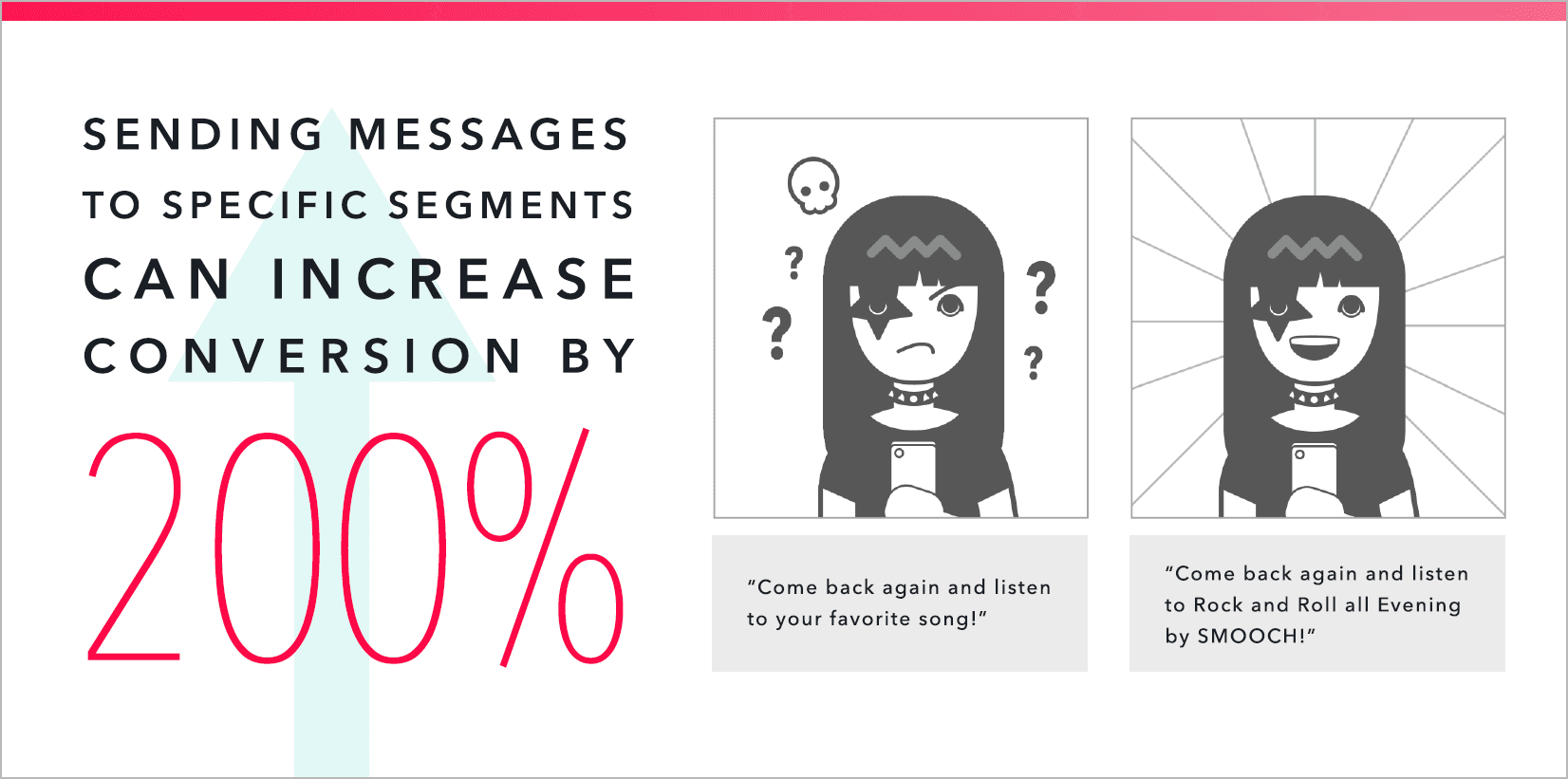The Secrets of Customer Segmentation Strategy
Published on September 14, 2016/Last edited on September 14, 2016/6 min read


Team Braze
Dear reader: This blog post is vintage Appboy. We invite you to enjoy the wisdom of our former selves—and then for more information, check out our new Cross-Channel Engagement Difference Report.
Know thy users. Then, segment them.
Your customer segmentation strategy is key for relevant and effective mobile marketing. Sending campaigns to smaller, thoughtfully constructed segments (vs. non-targeted blasts) can increase conversion by 200%.

Taking time to build, review, or revise segments can help you focus your messaging and your audience. Clarity on your audience will help ensure every message is valuable and that you won’t see opt-outs or lapsing engagement due to irrelevancy.
What is a segment?
A segment is a group of users you identify based on some set of characteristics, like lawyers, new users, or midnight shoppers. Depending on the data your CRM collects, you could develop a segment based around almost anything, but the point is to develop a comprehensive segmentation strategy that will help you reach your goals.
For example, let’s say an audio company with a concert-recording library available through their app has many live events in the U.S., but has an international user base. Among others, they may want to build a segment of their international users so that they can promote live-streams of those events. Targeting these users for live-stream campaigns can increase the likelihood of purchasing remote access and will also help to avoid making them feel left-out of the in-person events.
Segmentation is directly related to the development of personas, characters you can reference and focus on when developing messaging and special offers. Once you have identified and developed segments, you can go a step further with your messages and build in opportunities for personalization according to name, location, favorites, or other data.
How do you build a segment?
Segmenting gives you focus so that you can develop meaningful messaging and campaigns that effectively guide user actions toward your goals.
Based on your analytics or personas, your CRM should allow you to build segments or automatically populate lists based upon one or more criteria. Two broad categories of data you can use are user attributes or events (actions they have taken). By combining some, like iPhone users in their 20s that recently purchased an item, you can zero in on a segment and provide truly relevant content.
Examples of Attributes and Events in a Marketing CRM
ATTRIBUTESEVENTSGenderSessionsLocationLast Used App/SiteLanguageFirst Used App/SiteAgeCompleted RegistrationEmail AddressLast Item PurchasedDevice TypeLast Article ReadOperating SystemPush Opt-In StatusFavorite BrandsLast Received PushFavorite TeamLast Received EmailLifetime RevenueIn-App Messsage ClicksNumber of Rewards PointsLast Received Any CampaignNewsletter SubscriberCampaigns Received
Appboy allows you to select filters for actions like “last purchased product” or “last used app” to build the criteria for each segment. Once built and used in various channels, you can use the segments as lenses to analyze your results.
If your segments aren’t perfectly identified through the data available through your CRM (e.g. your segments are based on occupation, but you’ve never asked your users to select or confirm their profession), you’ll need to find some markers for tracking purposes (such as content they’ve read that indicates a particular profession). There are many different ways to segment through characteristics like user attributes (location, employment, age) but you can get a lot from focusing on events as you focus on encouraging more consistent engagement.
What are some examples?
Only you can identify the best approach for your business plan, but here are a couple examples to get your creative juices flowing:
One approach is to start with the power-users or most frequent customers and what works well for them. You’ll want to keep them happy but also guide more users to be big fans of your company like these folks are. Alternatively, you may find a segment has been nudged but is unlikely to return, and these might be best for a sunsetting plan.
By exploring installation information, you can determine what initially drew someone to your app, or what they were first interested in experiencing, and this could inform segments, such as favorite music genre.
Turo (formerly RelayRides), a peer-to-peer car leasing company, uses segmentation to adjust their available inventory based off of a customer’s age and behavior. This practice limits risk and reduces friction by segmenting their customers based on preferences and resulted in a 15% conversion rate.
Zedge made an important segmentation move when they realized many of their non-English speaking users were getting push notifications in a language they couldn’t understand. By making this important distinction based on language usage, they were able to greatly improve the effectiveness of their messages.
Customer segmentation top tips
To make the most of your messaging, here are a few customer segmentation strategy best practices and tips.
1. Have clear goals:
Be very clear about what you’re trying to achieve. This will drive the segments you build and the strategies you use to manage them. If you’re feeling stuck in your segmentation strategy, review your product goals and broader business goals to see how groups of people might fit into your ideal lifecycles.
2. Analyze and test:
Keep an eye on any analytics your system can provide for key segments and monitor performance over time. If particular campaigns excel for a particular segment, dive into your data to inform your future tactics. A/B or multivariate testing be particularly revealing to determine what works best for each group.
3. Develop segments and campaigns focused on the customer journey:
While you will likely have segments based around other characteristics, developing campaigns to re-engage lapsed users or reward your biggest fans can be great approaches to building stronger engagement.
4. Don’t over-segment:
Once you dig into the potential of segmentation, it can be a slippery slope that leads to the development of too many segments. Frank Luby of PresentTense suggests a “three-adjective rule” for your initial segments—if you can’t describe the group with three adjectives, it’s too complex. If your goal is to keep track of general activity, you don’t need a segment for every individual movie someone watched, but maybe you want to know if someone has watched five or more movies this week. Being more generic will help you target more users and draw more meaningful conclusions from your data.
Be Absolutely Engaging.™
Sign up for regular updates from Braze.
Related Content
View the Blog
How AI Decisioning Transforms Marketing (A Complete Guide)

Team Braze

AI decisioning cheat sheet: How to crawl/walk/run with BrazeAI Decisioning Studioᵀᴹ

Team Braze

A day in the life of a data scientist on the BrazeAIᵀᴹ forward-deployed engineering team
